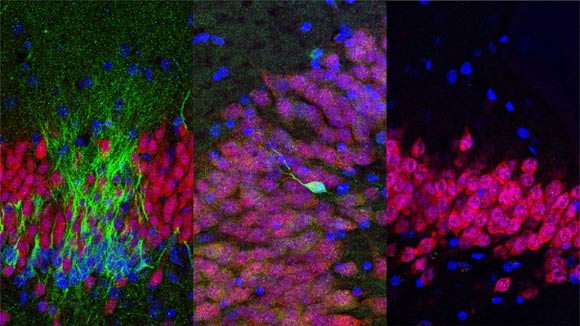An international team of neuroscientists has shown that in the hippocampus — a brain region important for learning and memory and one of the key places where scientists have been seeking evidence that new neurons continue to be born throughout the lifespan — neurogenesis declines throughout childhood and is undetectable in adults. Published in the journal Nature, the team’s results present a challenge to a large body of research which has proposed that boosting the birth of new neurons could help to treat brain diseases such as Alzheimer’s disease and depression. But the findings also open the door to exciting new questions about how the human brain learns and adapts without a supply of new neurons, as in seen in mice and other animals.

Young neurons (green) decrease in the human hippocampus across the lifespan, vs more mature neurons (red). Image credit: Sorrells et al.
“We find that if neurogenesis occurs in the adult hippocampus in humans, it is an extremely rare phenomenon, raising questions about its contribution to brain repair or normal brain function,” said co-lead author Professor Arturo Alvarez-Buylla, from the University of California San Francisco.
“Our new research suggests new neurons may not be born in the adult human brain at all.”
In the study, Professor Alvarez-Buylla and co-authors analyzed 59 samples of the human hippocampus obtained by University of California San Francisco and collaborators on three continents.
They analyzed changes in the number of newborn neurons and neural stem cells present in these samples, from before birth to adulthood, using a variety of antibodies to identify cells of different types and states of maturity, including neural stem cells and progenitors, newborn and mature neurons, and non-neuronal glial cells.
They also examined the cells they labeled based on their shape and structure — including imaging with high-resolution electron microscopy for a subset of tissue samples — in order to confirm their identity as neurons, neuronal stem cells, or glial cells.
The researchers found plentiful evidence of neurogenesis in a region of the hippocampus called the dentate gyrus (DG) during prenatal brain development and in newborns, observing an average of 1,618 young neurons per square millimeter of brain tissue at the time of birth.
But the number of newborn cells sharply declined in samples obtained during early infancy: DG samples from year-old infants contained fivefold fewer new neurons than was seen in samples from newborn infants.
The decline continued into childhood, with the number of new neurons declining by 23-fold between one and seven years of age, followed by a further fivefold decrease by 13 years, at which point neurons also appeared more mature than those seen in samples from younger brains.
The team observed only about 2.4 new cells per square millimeter of DG tissue in early adolescence, and found no evidence of newborn neurons in DG samples from adults.
“In young children, we were able to see that substantial numbers of new neurons continue to be made and integrated into DG, but neurogenesis fades away completely by early adolescence,” said co-author Dr. Mercedes Paredes, also from the University of California San Francisco.
“The fact that we could compare newborn brains, where new neurons were clearly present, to the adult, where we saw no evidence for young neurons, gave us added confidence that what we were seeing was correct.”
The researchers then turned to studying the stem cells that give birth to new neurons.
They found that neural progenitors are plentiful during early prenatal brain development, but become extremely rare by early childhood.
They noted that these cells fail to cluster early on into a concentrated ‘niche’ in a region of the human DG known as the subgranular zone.
They suspect that this configuration, which is seen in mice, could be necessary for prolonged neurogenesis, suggesting a potential explanation for why neurogenesis falters by adulthood in humans.
_____
Shawn F. Sorrells et al. Human hippocampal neurogenesis drops sharply in children to undetectable levels in adults. Nature, published online March 7, 2018; doi: 10.1038/nature25975







